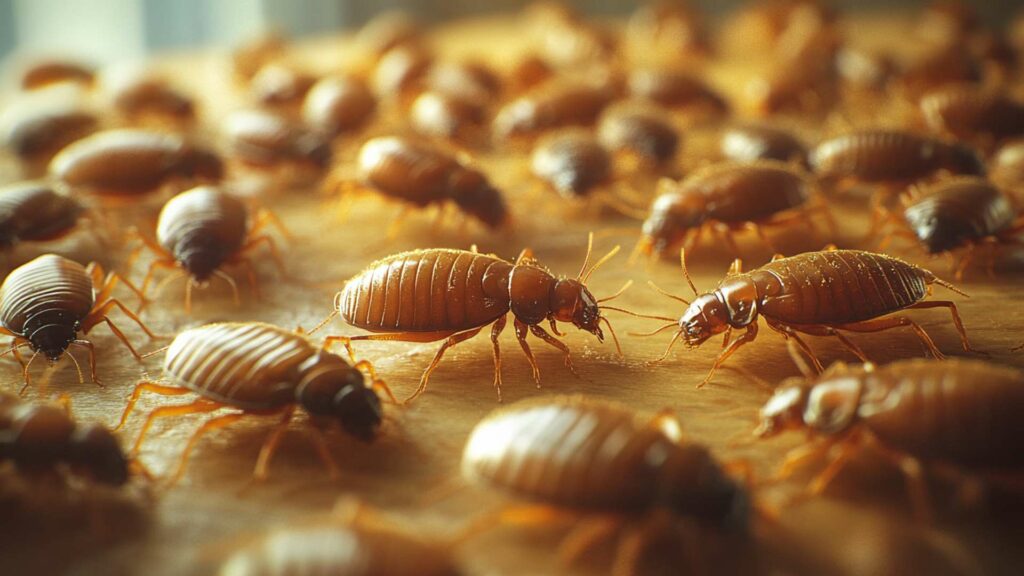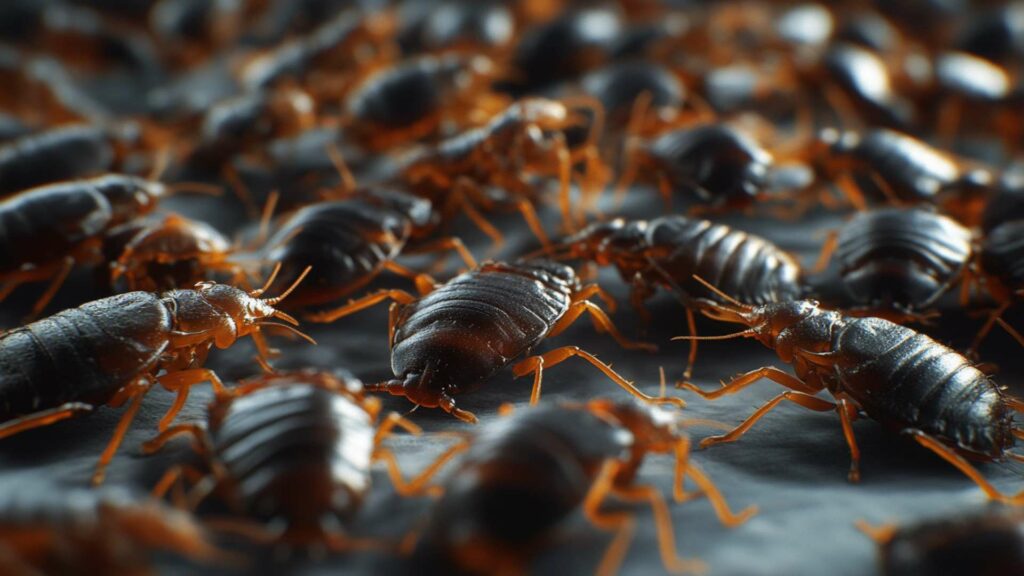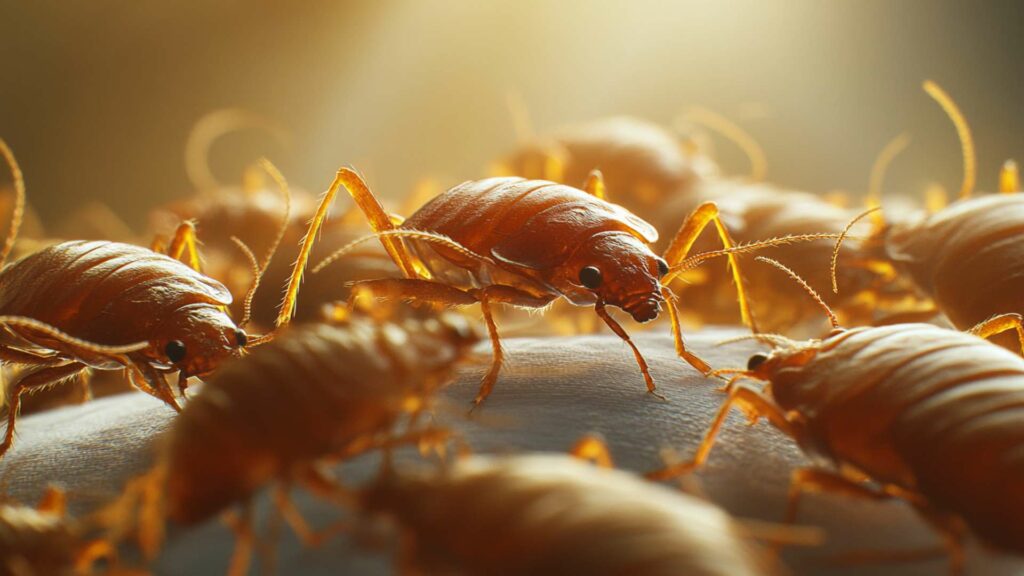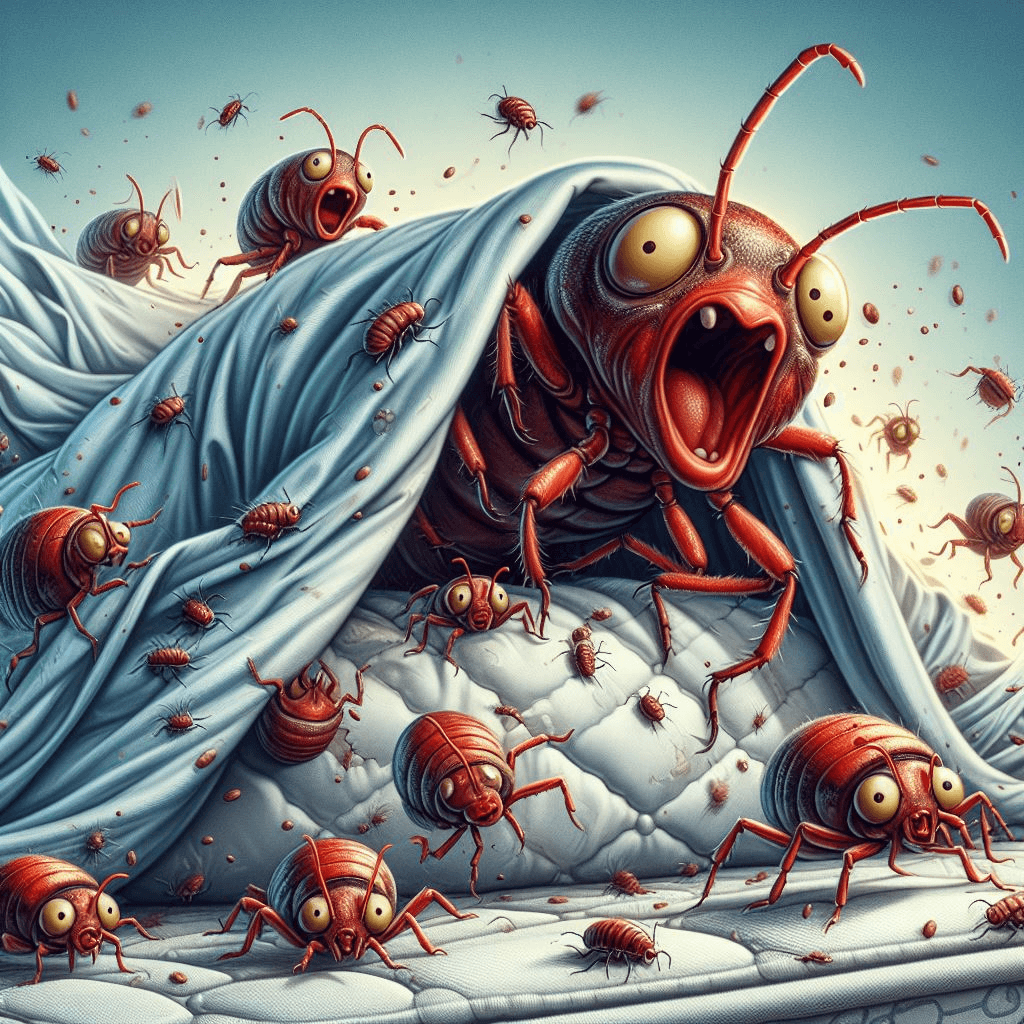What are bed bugs?
Bed bugs, scientifically known as Cimex lectularius, are small parasitic insects that feed on the blood of humans and other warm-blooded animals. They belong to the family Cimicidae and are notorious for being persistent pests.
These tiny creatures have a reddish-brown, oval-shaped body that is about the size of an apple seed when fully grown. While they cannot fly or jump like some other pests, bed bugs possess excellent climbing abilities which allow them to move swiftly across walls, floors, and furniture.
Discover the effectiveness of our professional bed bug control and treatment services as we tackle your bed bug infestation. Click here to explore further information about our exceptional services in controlling and treating bed bugs.
Why are they called bed bugs?
The name “bed bug” is quite fitting for these pesky critters due to their primary habitat preference: our beds. Bed bugs have a strong affinity for human sleeping areas as they rely on the warmth and carbon dioxide we emit during sleep to locate their hosts and feed on their blood.
Infestations often begin in mattresses or box springs but can quickly spread throughout a room or even an entire home if left unchecked. Although beds are their preferred hiding spot, bed bugs can also be found in cracks and crevices near sleeping areas, such as baseboards, furniture upholstery, curtains, and electrical outlets.
Where do bed bugs come from?
Bed bugs have been tormenting humans for thousands of years and can be found worldwide. Contrary to popular belief, having bedbugs does not indicate poor hygiene or cleanliness – these resilient pests can infest any type of dwelling regardless of its level of tidiness.
Bed bug infestations can occur in homes, hotels, dormitories, hospitals – anywhere people live or occupy regularly. It’s crucial to understand that anyone can inadvertently introduce these unwanted guests into their homes through various means such as traveling (bed bug hitchhikers), second-hand furniture, used clothing, or even visiting an infested location.
Being vigilant and proactive is essential in preventing and controlling bed bug problems. Now that we have a basic understanding of what bed bugs are, why they bear that name, and where they originate from, it’s time to delve deeper into identifying these pests and learning how to detect their presence in our living spaces.
Identifying Bed Bugs
Common Myths and Misconceptions About Bed Bugs
When it comes to bed bugs, there are many common myths and misconceptions that can cloud our understanding of these persistent pests. One of the most prevalent myths is that bed bugs are only found in dirty or unsanitary environments. However, the truth is that bed bugs can infest any space, regardless of its cleanliness. To learn more about dispelling these myths and gaining accurate information about bed bugs, check out our comprehensive article on common myths and misconceptions about bed bugs.
Do Bed Bug Repellents Work?
The search for effective bed bug repellents can be a daunting task. Many products claim to repel bed bugs, but their actual effectiveness may vary. To understand the truth behind bed bug repellents, it’s crucial to separate fact from fiction. Our article on do bed bug repellents work explores different types of repellents, their limitations, and offers insights on the most effective prevention and control strategies to combat bed bug infestations.
Are Natural Remedies Effective in Eliminating Bed Bugs?
Natural remedies have gained popularity as an alternative approach to eliminate bed bugs. From essential oils to DIY treatments, there are various claims about their efficacy. However, it’s essential to understand the limitations of natural remedies when dealing with bed bugs. Our informative article on are natural remedies effective in eliminating bed bugs explores the science behind these remedies, their potential benefits, and provides practical advice on integrating natural methods with professional pest control for the best results.
Can Pets Carry or Be Affected by Bed Bugs?
Pets are an integral part of our families, and it’s natural to be concerned about their well-being when dealing with bed bugs. The question of whether pets can carry or be affected by bed bugs often arises. Our article on can pets carry or be affected by bed bugs delves into this topic, providing insights on the role pets play in bed bug infestations and offering guidance on how to protect both your furry companions and your home.
Do Bed Bugs Have a Specific Season?
Understanding the seasonal behavior of bed bugs is crucial for effective prevention and control. While some pests have specific seasons of heightened activity, bed bugs can be a year-round nuisance. To grasp the seasonality of bed bugs and develop proactive strategies, explore our informative article on do bed bugs have a specific season. Gain insights on their behavior throughout the year and learn how to stay vigilant regardless of the season.
What do bed bugs look like?
When it comes to identifying these pesky creatures, it’s essential to know what bed bugs look like. Adult bed bugs are small, flat, and oval-shaped insects with a reddish-brown color. They have six legs and antennae, giving them a somewhat creepy appearance.
Bed bugs go through different stages of development before reaching adulthood. Nymphs, which are the younger bed bugs, are lighter in color and smaller in size than the adults.
How big are bed bugs?
Bed bug sizes can vary depending on their stage of development. Adult bed bugs typically measure about 4 to 5 millimeters in length, which is roughly the size of an apple seed. They have a relatively flat body that allows them to hide easily in tiny crevices such as mattress seams or cracks in furniture.
Can you see bed bugs with the naked eye?
Yes, you can see bed bugs with the naked eye! While they may be tiny critters, they are not microscopic. Adult bed bugs are visible without any magnification equipment; however, their small size can make them difficult to detect, especially if you don’t know where to look or what signs to search for.
It’s important to note that despite being visible, their ability to hide in various spots and their nocturnal feeding habits make spotting them quite challenging. So keep your eyes peeled for these elusive creatures when inspecting your living space for signs of a potential infestation!
Bed Bug Infestations

How do bed bug infestations start?
Bed bug infestations can start in various ways, but one of the most common is through hitchhiking. Bed bugs are excellent travelers and can easily latch onto luggage, clothing, or furniture.
You might unknowingly pick up these pests from a hotel room, public transportation, or even a friend’s house. They then make their way into your home and find cozy hiding spots to settle in.
Where do bed bugs hide in your home?
Bed bugs are notorious for their ability to hide in small crevices and cracks. They prefer dark and warm spaces close to human activity, as they are nocturnal creatures that feed on blood.
Some common hiding spots include mattress seams, behind headboards, inside electrical outlets, and along baseboards. However, bed bugs can also be found in unusual places like picture frames, alarm clocks, or even inside books.
Common hiding spots for bed bugs
When it comes to choosing hiding spots within your home, bed bugs have certain preferences. These pesky creatures tend to gravitate towards areas where they have easy access to their hosts during the night. This includes mattresses and box springs since they provide a convenient hiding place close to where people sleep.
Additionally, bed bugs may also seek refuge in upholstered furniture such as couches or chairs because they offer numerous crevices for them to disappear into during daylight hours. Other common hiding spots include curtains or drapes near bedsides or behind wall decorations.
Unusual hiding spots for bed bugs
While you might expect bed bugs to limit themselves to typical areas like mattresses and furniture, it’s important not to underestimate their ability to adapt and seek out less expected locations within your home. Some unusual places where bed bugs live and have been found include within the folds of clothing stored in drawers, behind loose wallpaper or peeling paint, and even inside electrical appliances.
The flat bodies of bed bugs allow them to squeeze into narrow gaps that may be inaccessible to other pests. To effectively combat bed bug infestations, it’s crucial to thoroughly inspect all potential hiding spots and treat them accordingly.
Remember, a comprehensive approach is necessary to eradicate these resilient pests from your home entirely.
Detecting Bed Bugs
How can you tell if you have a bed bug infestation?
Discovering a bed bug infestation in your home can be distressing, but it’s crucial to spot the signs early on to prevent the problem from escalating. Bed bugs are sneaky creatures that hide during the day and come out at night to feed on unsuspecting humans. Keep an eye out for these telltale signs to determine if you have a bed bug problem.
Signs of bites on your body

One of the most common indicators of a bed bug infestation is waking up with unexplained bites on your body. Bed bugs typically bite exposed skin, such as the arms, legs, neck, or face.
These bites often appear as small red welts or clusters and can cause itching and irritation. However, it’s important to note that not everyone reacts to bed bug bites in the same way; some people may not show any visible signs at all.
Blood stains on bedding or furniture
Another clue that points towards a potential bed bug infestation is the presence of blood stains on your bedding or furniture. When engorged with blood after feeding, bed bugs may accidentally get crushed while moving around, leaving behind small reddish-brown stains.
You might notice these stains on your sheets, pillowcases, or even upholstered furniture where bed bugs tend to hide during the day. If you spot these tiny specks of blood regularly, it’s time to investigate further.
Dark spots or fecal stains on mattresses or walls
Bed bugs leave behind dark spots or fecal stains in their wake as they travel and feed. These marks are often found near their hiding places – like mattress seams and cracks in walls – where they leave behind their excrement.
These markings resemble tiny black dots or smears and may be more visible on lighter-colored surfaces. If you notice these stains on your bedding, walls, or furniture, it’s a strong indication of a bed bug infestation that requires prompt attention.
Remember that early detection is key to effective bed bug control. If you suspect a bed bug infestation based on these signs, it’s advisable to seek professional help from a reputable pest control company to tackle the problem promptly and efficiently.
Tips for Avoiding Bringing Home Bed Bugs from Travels
Traveling is an exciting and enriching experience, but it’s essential to be cautious about the potential hitchhikers that may accompany you back home. Bed bugs are notorious for infesting hotel rooms and can easily latch onto your luggage or clothing, sneaking into your house undetected. To minimize the risk of bringing these unwanted pests home, here are some tips to keep in mind:
Inspecting Hotel Rooms for Signs of Infestation
When you enter your hotel room, take a few minutes to do a thorough inspection for any signs of bed bugs. Start by examining the mattress seams, as these tiny pests often hide there. Look for small brownish spots or eggshells that bed bugs leave behind.
Check all areas near the bed, including the headboard, nightstands, and even behind framed pictures on the walls. Pay close attention to cracks and crevices where these critters can hide during the day.
Using Luggage Encasements and Other Preventive Measures

To protect your luggage from potential bed bug encounters during your travels, consider investing in luggage encasements specifically designed to prevent infestations. These encasements create a barrier that keeps any hidden bugs away from your belongings.
In addition to using encasements, it’s also helpful to elevate your luggage off the floor on a stand or rack when staying in hotels. This simple step makes it harder for bed bugs and other insects to climb up onto your suitcases or bags.
Getting Rid of Bed Bugs
DIY methods for eliminating small infestations
When dealing with a small bed bug infestation, there are several effective do-it-yourself methods you can try before calling in the professionals. One popular method is steam treatment combined with thorough vacuuming. Bed bugs cannot withstand high temperatures, so using a steamer on your mattress, furniture, and other affected areas can kill these pests and their eggs.
Be sure to carefully move the steamer across all surfaces for maximum effectiveness. After steam treatment, it’s crucial to vacuum the treated areas thoroughly.
Pay extra attention to crevices, seams, and any tiny specks or eggs you come across. Use a vacuum with a high-efficiency particulate air (HEPA) filter to ensure that captured bed bugs don’t escape back into your home.
Remember to promptly discard the vacuum cleaner bag in a sealed plastic bag outside your house to prevent any potential re-infestation. Another important step in DIY bed bug elimination is laundering and drying any affected items such as clothing, linens, and curtains.
Wash these items in hot water (at least 120°F) for a minimum of 30 minutes to kill the bed bugs effectively. Additionally, consider using scented dryer sheets in the dryer as they may act as a deterrent for these pesky pests.
Professional extermination options
If your bed bug infestation persists or becomes too overwhelming for DIY methods, it may be time to seek professional help. Pest control professionals have access to specialized tools and treatments that can eradicate bed bugs effectively. One common professional extermination option is heat treatment.
This method involves raising the temperature of the affected area (typically over 120°F) using specialized equipment. Heat penetrates deep into furniture, mattresses, walls, and other hiding spots where bed bugs may reside, effectively killing them and their eggs.
It’s important to note that this treatment requires proper preparation and should only be done by trained professionals. Chemical treatments are another option that professionals may use.
These treatments involve the application of insecticides in specific areas where bed bugs are present, eliminating them over time. Professionals will choose the most appropriate chemical treatment based on the severity of the infestation and your specific circumstances.
It’s crucial to follow all instructions provided by the exterminator, including any precautions or post-treatment recommendations. Remember, whether you choose to tackle bed bug infestations yourself or opt for professional assistance, thoroughness is key in completely eliminating these unwelcome pests from your home.
Dealing with Bed Bug Bites
Identifying and treating bites

When it comes to bed bug bites, one of the first steps is to identify them correctly. Bed bug bites typically appear as small, red, itchy bumps on the skin.
They are often arranged in a line or cluster and can be accompanied by swelling or a rash around the affected area. It’s important to note that bed bug bites might not be immediately noticeable as they can take several days to develop symptoms.
If you suspect you have been bitten by bed bugs, it’s crucial not to scratch the affected areas as this can lead to infections. Instead, focus on alleviating the itchiness and discomfort.
Washing the bites with mild soap and water can help cleanse the area and reduce any potential bacterial infection. Applying over-the-counter hydrocortisone cream or calamine lotion can provide relief from itching.
Home remedies to alleviate itching and discomfort
While professional medical advice should always be sought for severe reactions or persistent symptoms, there are some home remedies that may help alleviate the itching and discomfort caused by bed bug bites. One effective remedy is applying a cold compress or ice pack wrapped in a cloth directly on the affected areas. The cold temperature helps numb the skin and reduces swelling and itching temporarily.
Another commonly used household item is baking soda paste—a mixture of baking soda and water applied topically on the bites can soothe irritation. Natural oils like tea tree oil or lavender oil may also provide relief when applied directly onto bed bug bites.
These oils have anti-inflammatory properties that can calm irritated skin. However, it’s important to remember that essential oils should always be diluted properly before use.
Remember, while these home remedies may help alleviate symptoms temporarily, they do not address the root cause of your problem—bed bugs themselves! Proper treatment for eliminating these pests requires thorough cleaning, vacuuming, and potentially professional extermination methods.
Identifying bed bug bites correctly is essential for appropriate treatment. Mild soap and water, along with over-the-counter creams, can help alleviate itching and discomfort.
Home remedies such as cold compresses, baking soda paste, or natural oils may provide temporary relief. However, it’s crucial to address the underlying issue of bed bug infestations to completely eliminate the problem and prevent future bites.
Myths and Misconceptions about Bed Bugs
Bed bugs are only found in dirty or unkempt homes
One of the most common misconceptions about bed bugs is that they only infest dirty or unkempt homes. In reality, bed bugs can be found in any environment, regardless of cleanliness.
These insects are excellent hitchhikers and can easily find their way into your home through luggage, used furniture, or even on clothing. So, don’t assume that just because your home is clean that you are immune to a bed bug infestation.
Bed bugs only infest beds

Contrary to popular belief, bed bugs do not limit themselves to beds alone. While they prefer to hide in the crevices of mattresses and bed frames due to easy access to their human hosts during the night, they can also be found in other areas of your home.
Common hiding spots for bed bugs include cracks in walls, electrical outlets, baseboards, upholstered furniture, and even behind picture frames. It’s important to thoroughly inspect all areas if you suspect a bed bug infestation.
You can get rid of bed bugs by turning up the heat
While it is true that high temperatures can kill bed bugs and their eggs, simply turning up the heat in your house won’t effectively eliminate an infestation. Bed bugs have developed resistance to high heat over time and can survive extreme temperatures for short periods.
To eradicate them successfully using heat treatment, professional equipment with precise temperature controls is necessary. DIY attempts like using hairdryers or space heaters may prove ineffective and potentially dangerous.
Conclusion
Understanding the truth behind common myths and misconceptions about bed bugs is crucial for dealing with these pesky insects effectively. Remember that cleanliness alone cannot prevent an infestation of bed bug populations since these hitchhikers can find their way into any home. Also, be aware of their hiding spots beyond just beds.
While heat can be an effective method for addressing bed bugs, seek professional help for proper heat treatment to ensure complete eradication. By debunking these myths and equipping yourself with accurate knowledge, you can approach the issue of bed bugs with confidence and take appropriate steps to protect your home.
Remember, it’s important not to panic if you encounter a bed bug infestation—professional exterminators have effective methods for treating this problem. With the right approach and expert help, you can regain control over your living space and eliminate these bothersome bugs once and for all!
Frequently Asked Questions:
It is not recommended to sleep in a bed with bed bugs as it can lead to further infestation and bites.
Bed bugs are not contagious in the typical sense as they do not spread from person to person. They can, however, spread within an infested area.
Bed bug bites may appear within a few hours to several days after being exposed to bed bugs.
After bed bug treatment, it is advisable to follow the recommendations provided by the pest control professional regarding when it is safe to sleep in your bed again.
If you found this article appealing, you might also discover value in these kindred writings:
Unmasking the Elusive: A Comprehensive Guide to Bed Bug Infestation Signs and Detection








